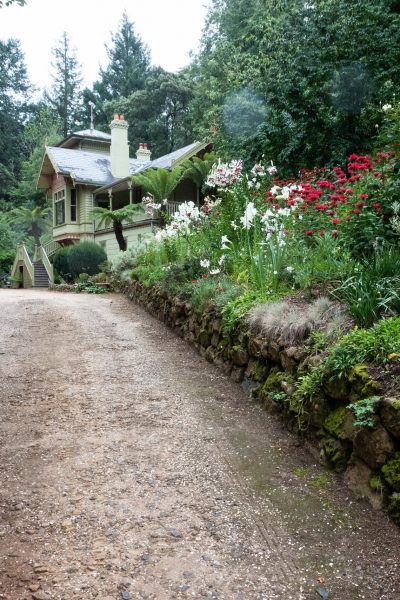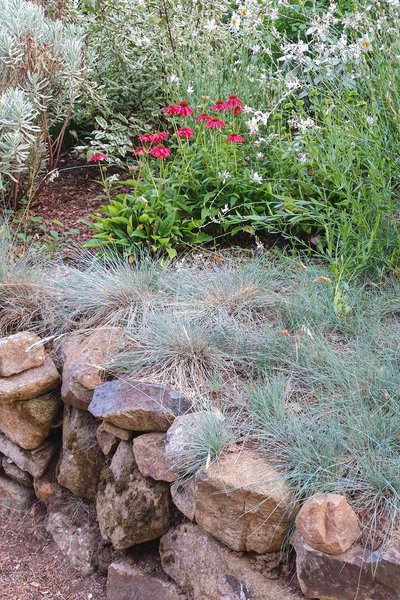[ad_1]
Maybe your whole garden is sloping? O perhaps you just have to plant on a slope in one border?
Either way, it can be frustrating. I only have the tiniest bit of sloping border but plants don’t do well in it. I’m never quite sure exactly how to plant.
And when I water the newly planted specimen, water trickles away, carrying soil with it.
On the other hand, slopes offer a magnificent opportunity to show off layers of plants. And individual plants usually get more light.
This is at a house called Karori, which is on a steep slope. But it still has this magnificent herbaceous border with lilies, monarda, dahlias and more.
So I asked the advice of plantsman and broadcaster Stephen Ryan of Dicksonia Rare Plants near Melbourne, Australia.

Stephen Ryan showing me how to plant on a slope.
Water is the main issue on a slope
The main problem with a slope is that water trickles (or rushes) down to the bottom, carrying soil and plant nutrition with it.
When you plant up a slope, Stephen advises digging a series of almost invisible trenches across the bank. They need be no more than 3″-4″ deep and will be barely visible once the bank is planted up.
These tiny ditches (Stephen calls them ‘swales’) will hold water, allowing it to seep slowly into the soil.

You then leave them in place as they will slowly be covered over by the plant’s growing foliage or by falling leaves. But by the time, they have disappeared, your plant’s root system should be well established.
Planting a slope in itself helps it retain water and soil.
If you have an irrigation system, you can run your hosepipe along the ditches.
Step 2: how to plant on a slope
The best place to plant is directly below one of these tiny ditches. (Just dig the ditches above where you want to plant!)
Stephen then uses a large stone or a couple of bricks to create a small ‘retaining wall’ on the lower edge of the hole.

This persicaria has been planted into a hole with a couple of bricks wedged in the lower edge. This will help create a reservoir for watering.
‘It doesn’t require engineering,’ he says. It’s just a question of wedging a brick or two in the plant’s hole, at the edge, to create a mini reservoir, so that water can puddle behind it.
You then plant into the hole as normal, filling with soil and compost. Water into the hole and along the little ditch above.
Then cover the area with mulch.
The best mulch for a sloping border
Stephen recommends using a fairly coarse mulch on a slope. Roughly chopped tree bark or straw is ideal.
Rain can penetrate it, but it will help hold water in place.

These sloping borders at Karori are mulched with their own tree bark mulch. made by shredding their tree prunings.
If you want to feed the soil with manure or garden compost, then add the straw or bark mulch on top to help hold it on the bank.
Which plants are best for a slope?
There are quite a few studies by agricultural colleges which conclude that you need deep rooted plants for a slope.
However, what works in agriculture doesn’t always reproduce exactly in gardens. The slopes in gardens and the total areas are much smaller, for a start.
Deep rooted plants are, indeed, good for slopes but Stephen doesn’t think you need to limit yourself to them when you plant on a slope. He thinks that mat-forming plants are also ideal.

The main border at Karori has a mix of plants – some are particularly good for slopes. However it’s been possible to use a wide choice of plants because the ones that spread well, such as euphorbia and festuca glauca help hold the soil in place for the other plants.
Mat-forming plants for slopes
Stephen suggests you look for plants that create a thick ground cover over the soil as their foliage spreads. It’s not easy to weed slopes because access is usually difficult.

These carnations have clumped out, covering the bank on which they are planted and depriving weeds of an opportunity to grow.
So by blocking out the light with thick plant foliage, fewer weeds will grow.
Or choose plants whose roots spread through the soil easily. Ferns and ivy are the classic plants for slopes. But Stephen also thinks that many euphorbias are good spreaders, as are persicarias. Although the latter do prefer a fairly damp climate.

This is actually a very steep slope but the ferns in the foreground stop rainwater from rushing down the bank.

Festuca glauca (Blue fescue) at the edge of Karori’s herbaceous border. It has mat forming roots so is ideal for a slope.
Anything else you need to know about planting on a slope?
The rules about plant heights are very different when you plant on a slope, explains Stephen.
‘In an ordinary border, you will probably put the taller plants at the back,’ he says. ‘But if you do that on a slope, you’ll get a back row which towers over the rest. That won’t look so good.’
Karori, the garden I’ve featured here, has tall plants like lilies near the front of the border, although there are also some cannas at the back. Many of the other plants are similar heights, so once they are planted on a slope, the heights look natural.
See how to plant on a slope on video:
You can often see more of a garden on video, so here is the full interview with Stephen.
Shop my favourite gardening books, tools and products
I’m often asked for recommendations, so I’ve put together lists of the gardening books, tools and products I use myself on the Middlesized Garden Amazon Store.
Note that links to Amazon are affiliate which means I may get a small fee if you buy, but I’ll only recommend things I use myself or think you will really like.
For example, my good books on plants list has the books I would recommend reading when you are planning a border. They include books on planning garden colour – such as Nick Bailey’s 365 Days of Colour.
More about Stephen Ryan
Stephen Ryan was the presenter on Gardening Australia, the Australian equivalent of Gardeners World. He runs a rare plant nursery, Dicksonia Rare Plants, near Melbourne and gives gardening talks and tours all over the world. He also has several regular radio slots, such as ABC Radio, Central Victoria.
Read his tips on how to grow cannas and also how to create an exotic garden in a cool climate.
Pin to remember how to plant on a slope
And do join us every Sunday morning – follow the Middlesized Garden blog by email!

[ad_2]
Source link
